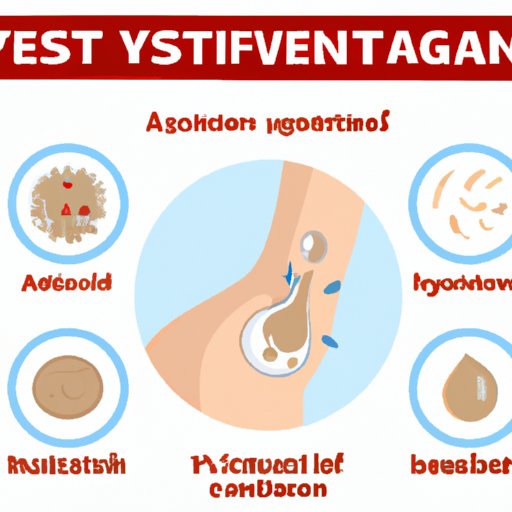
I. Introduction
If you’re a woman, you’ve probably heard horror stories about yeast infections. These common fungal infections can cause a range of uncomfortable symptoms, from itching and burning to swelling and discharge. While yeast infections are rarely serious, they can be incredibly unpleasant, and they’re not always easy to identify. In this article, we’ll explore how to tell if you have a yeast infection, as well as the most effective ways to treat and prevent them.
II. Symptoms of a yeast infection
Yeast infections are caused by an overgrowth of a type of fungus called Candida. This fungus is naturally present in the body (especially in the mouth, gut, and vagina), but it can quickly grow out of control under the right conditions. Yeast infections are most common in women, but men can get them too.
The most common symptoms of a yeast infection include:
- Itching or burning in the vagina or on the vulva
- Soreness or swelling in the vulva
- Pain or discomfort during sexual intercourse or urination
- Redness or rash on the vulva
- Thick, white discharge that looks like cottage cheese
In some cases, a yeast infection may cause other symptoms, such as bloating, constipation, or diarrhea. These symptoms are less common but can still indicate a yeast infection.
III. Causes of a yeast infection
Yeast infections are caused by an overgrowth of the Candida fungus. This overgrowth can be triggered by a variety of factors, including:
- Tight clothing or underwear that traps moisture
- Antibiotic use, which can kill off the body’s natural balance of yeast and bacteria
- A diet high in sugar or refined carbohydrates, which can feed the fungus
- A weakened immune system, which can make it harder for the body to fight off infections
While anyone can get a yeast infection, certain factors can increase your risk. These include:
- Pregnancy
- Diabetes
- Use of hormonal birth control
- Use of corticosteroid medications
- Sexual activity, especially with a partner who has a yeast infection
IV. Risk factors for a yeast infection
If you have any of the risk factors listed above, it’s important to be aware of the signs and symptoms of a yeast infection. This can help you get treatment more quickly and avoid complications.
V. Home remedies for yeast infections
Many people prefer to use natural or home remedies to treat mild yeast infections. Some popular remedies include:
- Plain, unsweetened yogurt, which contains beneficial bacteria that can help restore the body’s natural balance of yeast and bacteria
- Garlic, which is thought to have antifungal properties
- Tea tree oil, which can be applied topically to the vulva to relieve itching and pain
- Apple cider vinegar, which can be added to a warm bath or applied topically to help restore the body’s natural pH balance
While these remedies can be effective, it’s important to use them safely and correctly. Make sure to follow the instructions carefully and stop using the remedy if you experience any adverse effects. If your symptoms don’t improve after a few days of home treatment, or if they get worse, it’s a good idea to see a healthcare provider.
VI. Over-the-counter treatment options
If your symptoms are more severe or prolonged, you may need to use an over-the-counter antifungal medication. These medications come in a variety of forms, including creams, suppositories, and oral tablets. Some of the most commonly used medications include:
- Miconazole (Monistat)
- Clotrimazole (Lotrimin)
- Terconazole (Terazol)
- Fluconazole (Diflucan)
Each of these medications works slightly differently, and you may need to try a few before you find the one that works best for you. It’s important to follow the instructions carefully and finish the entire course of treatment, even if your symptoms improve before it’s completed.
VII. When to see a doctor
If your symptoms don’t improve after a few days of home treatment, or if they get worse, it’s a good idea to see a healthcare provider. Additionally, if you experience any of the following symptoms, you should seek medical attention right away:
- Fever or chills
- Severe pain or discomfort
- Abnormal discharge (e.g. yellow or green)
- Blisters, sores, or ulcers on the vulva
When you visit your healthcare provider, they may perform a pelvic exam to check for signs of infection. They may also take a sample of vaginal discharge or use a swab to test for the presence of yeast. If you are diagnosed with a yeast infection, your healthcare provider can prescribe medication to help clear it up.
VIII. Prevention methods
To reduce your risk of getting a yeast infection, there are several things you can do:
- Wear loose-fitting clothing and cotton underwear, which allow air to circulate and reduce moisture
- Avoid douching, which can disrupt the natural balance of yeast and bacteria
- Practice good hygiene, including washing your genitals with mild soap and water
- Eat a healthy, balanced diet that’s low in sugar and rich in probiotics
- Manage any underlying medical conditions, such as diabetes or HIV, that can weaken the immune system
By taking these steps, you can help promote a healthy balance of yeast and bacteria in your body, reducing your risk of getting a yeast infection.
IX. Conclusion
Yeast infections are a common and often irritating condition that can cause a range of uncomfortable symptoms. While they’re rarely serious, it’s important to identify and treat yeast infections quickly and effectively to avoid complications. By understanding the signs and symptoms of a yeast infection, as well as the most effective treatment and prevention methods, you can take control of your health and minimize your risk of future infections.
Remember: if you suspect you may have a yeast infection, don’t hesitate to seek medical attention.





